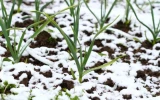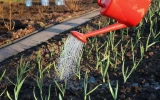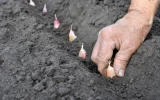How Much Water Do Garlic Plants Need to Grow?
Garlic thrives under specific watering conditions, requiring a delicate balance of moisture to develop its flavorful bulbs. Too little water can hinder growth, while excessive moisture may lead to root rot and other diseases. This article will explore the intricacies of watering garlic plants, providing insights into the ideal moisture levels for optimal growth.
Garlic plants require about 1 inch of water per week during their growing season. Consistent moisture is crucial, especially during bulb formation. Over-watering can lead to fungal diseases and root rot, while under-watering can result in smaller bulbs.
Mulching helps retain soil moisture and reduce watering needs. As you read further, we will also offer tips on adjusting watering techniques based on weather conditions and soil types, ensuring gardeners can cultivate healthy, flavorful garlic bulbs.
Summary
- Adjust watering based on the garlic's growth stage and season by starting with less frequent watering until shoots emerge, increasing to about 1 to 1.5 inches per week during active growth, and reducing as harvest approaches to firm up bulbs.
- Seasonal watering considerations emphasize the need for consistent moisture during active growth periods (spring and summer) and reduced watering in fall and winter, adjusting for local climate and weather patterns to prevent over-saturation or dehydration.
- Stop watering garlic when the lower leaves begin to turn yellow, signaling the end of its growth cycle and the start of bulb maturation, which is crucial for developing strong skins, concentrating flavor, and preventing disease.
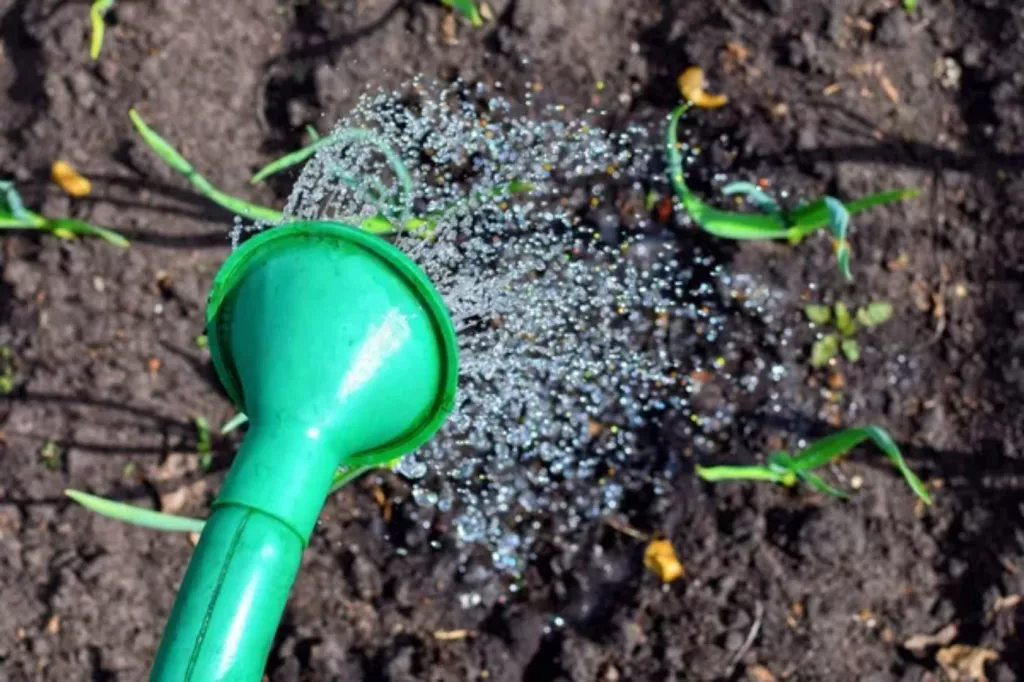
On this page:
- Basic Water Requirements for Garlic
- Signs of Adequate Hydration in Garlic Plants
- Effects of Overwatering and Underwatering
- Watering Techniques for Optimal Growth
- Seasonal Watering Considerations
- How Much Water Does Garlic Need per Week?
- How Often to Water Garlic in Summer
- How Much Water Does Garlic Need in the Winter?
- How Much Water Do Garlic Plants Need in the Fall
- When to Stop Watering Garlic
- Best Irrigation for Garlic
Basic Water Requirements for Garlic
Garlic plants have specific watering needs that must be met for optimal growth. Initially, you'll want to aim for about 1 inch of water each week, which helps establish strong roots. To achieve this, regular watering is more beneficial than sporadic, heavy soaks.
The soil should remain moderately moist but never waterlogged. Good soil drainage is crucial to prevent bulb rot.
In sandy soils, or during periods of dry weather, you may need to water your garlic more frequently. Employing mulch can assist in retaining soil moisture and reduce the need to water as often.
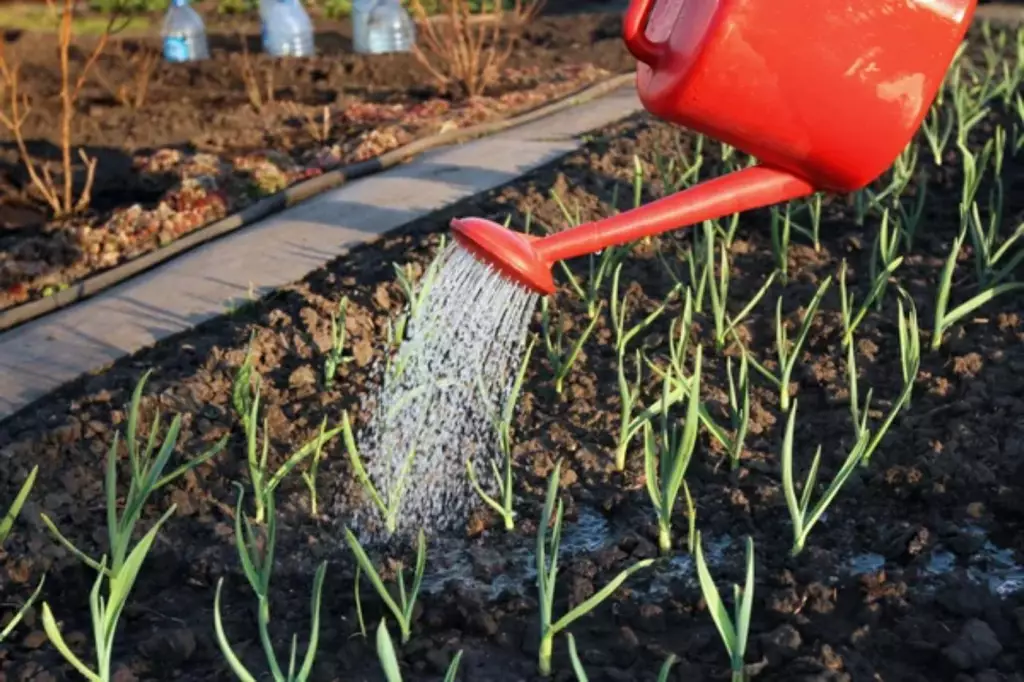
Remember to consider the weather and your soil type when you water your garlic. If it rains, adjust your watering accordingly to avoid overwatering. If you're unsure, touch the soil—it should feel moist at an inch below the surface.
Signs of Adequate Hydration in Garlic Plants
When caring for your garlic plants, identifying the telltale signs that they’ve received enough water is key for a bountiful harvest. Adequate hydration is indicated by certain visual cues and soil conditions that you can easily check.
Visual signs of sufficient hydration
- Healthy leaves: Your garlic plants should have vibrant green leaves. If they look lush and stand erect, it's a good sign they're well-hydrated.
- Steady growth: Consistent growth of both the leaves and the stems typically indicates sufficient water intake.
Soil indicators
- Moist soil: The soil around your garlic should be moist when you touch it. A simple test is to stick your finger into the soil about an inch deep. If it feels dry at that depth, it’s time to water.
- Organic matter: Incorporating organic matter like compost into the soil helps retain moisture, which reduces the need for frequent watering.
Absence of stress signals
- Lack of wilting: If the leaves are not wilting or turning yellow, your garlic is likely getting the water it needs.
- No bulb softness: Gently check the base of your garlic plants. The bulbs should be firm, a sign they are hydrating appropriately from the soil.
Effects of Overwatering and Underwatering
Too much water can lead to overwatering issues. You'll see your garlic plants struggle with fungal diseases, and the bulbs might become soft or even rot, an unwanted condition exacerbated by poor drainage.
On the flip side, underwatering can stress your garlic plants, leaving them weak against pests. The bulbs won't grow well if they're thirsty, and you might notice the leaves turning yellow and wilted. To combat this, ensure your watering schedule allows the soil to stay consistently moist, but not overly wet.
Here's a quick guide on what to look out for:
- Overwatering: Soil is soggy, leaves are yellow, potential increase in fungal diseases, and bulb rot.
- Underwatering: Soil is dry, plants are droopy, and slow bulb growth.
Your garlic's need for water changes over its growing period. In the beginning, water sparingly until the shoots emerge.
Then shift to a regular watering schedule, ensuring about 1 to 1.5 inches per week, depending on your local climate and soil conditions.
A good rule of thumb is to decrease watering as harvest time approaches, allowing the bulbs to firm up. Remember, moderation is key to avoiding both extremes.
Watering Techniques for Optimal Growth
When growing garlic in your garden, it's crucial to provide the right amount of water for the plants to thrive. Garlic requires consistent moisture, especially during the bulb-forming stage, but overwatering can be just as harmful as underwatering.
-
Regular schedule: Aim to water your garlic plants every 3-5 days, ensuring that the soil remains moist but not waterlogged.
-
Depth check: Water should reach deep enough to saturate the soil to about 1-2 inches. This encourages strong root development.
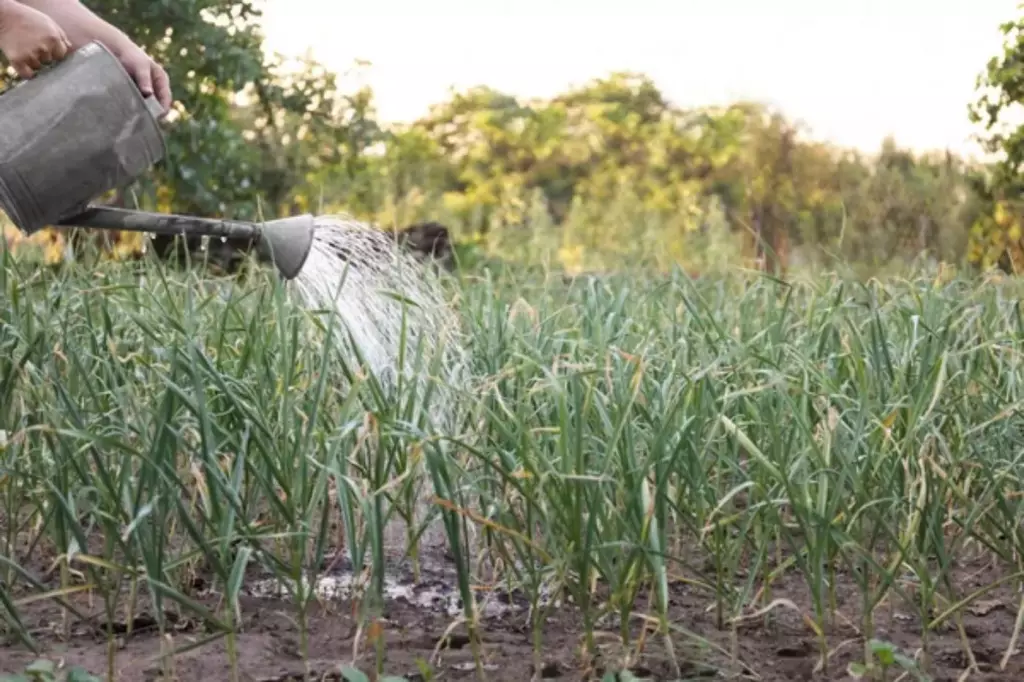
- Mulch benefits: Using an organic mulch, such as straw or leaves, helps retain moisture in the soil, reduces weeds, and protects against extreme temperatures. For tips on how to apply mulch, check this article.
Here's a quick reference to keep you on track:
| Climate | Watering Frequency | Soil Moisture Level |
|---|---|---|
| Dry/sunny | Every 3 days | Evenly moist |
| Humid/cloudy | Monitor soil; less frequent | Moist but not saturated |
Remember to adjust your watering frequency based on weather conditions. During a week with ample rain, you can skip the regular watering.
In contrast, if your garlic is exposed to full sun and the soil dries out quicker, an increase in watering may be necessary. Always check the soil moisture before watering to reduce the risk of over-saturation.
Seasonal Watering Considerations
Watering your garlic plants correctly is crucial, and it largely depends on the season and your local climate. Below are some seasonal specifics to ensure your garlic gets the right amount of water at the right time.
Spring watering
In spring, your garlic is actively growing and thus requires consistent moisture. After fall planting, start watering when the ground thaws.
You should aim to keep the soil evenly moist, providing about 2.5 cm of water each week especially as the weather warms up. Be mindful of the natural rainfall in your area and adjust accordingly.
Fall watering
During fall, watering aids your newly planted garlic cloves to establish roots before the winter sets in. Water your garlic plants moderately after planting them in the fall but cut back as temperatures drop and rains become more frequent.
Mulch can help retain soil moisture and protect your plants against the harshness of the first frosts.
Winter watering concerns
Once winter arrives and the ground starts to freeze, your garlic plants enter a dormant state, which helps them survive frost.
Watering is generally not necessary during this time. The combination of cooler temperatures and less intense sunlight means that garlic requires far less water.
Furthermore, excessive watering in winter could lead to rot, as waterlogged soil can freeze and damage the cloves.
Be cautious of the microclimate in your garden; if you live in the south with milder winters, occasional light watering could still be necessary if there's no sufficient rain.
How Much Water Does Garlic Need per Week?
During a typical week, garlic requires about 2.5 cm (1 inch) of water. Whether you're watering once a week or spreading it out over a few days, keep this total amount in mind.
In specific conditions, like sandy soil or during periods of drought, your garlic plants may need more frequent watering.
To ensure they thrive, aim to replace up to 130% of the daily evaporation rate and maintain even moisture throughout the upper 40-60 cm (16-24 inches) of soil.
Remember to adjust accordingly if you receive natural rainfall; you may need to water less often.
Keep an eye on the soil moisture and consider using a rain gauge to help track how much water your garlic is receiving naturally.
How Often to Water Garlic in Summer
In the summer, your garlic plants will thrive with consistent moisture. Aim to water your garlic once every 3 to 5 days, ensuring the soil remains moist but not waterlogged.
During hotter spells, check the soil below the surface. If it feels dry, it's time to water. A simple method to test this is by inserting your finger into the soil up to the second knuckle.
Make sure that the water penetrates deep enough to reach the garlic's roots, which will encourage proper growth and bulb development. Avoid shallow watering as it might not reach the deeper roots and could also lead to weaker plants.
How Much Water Does Garlic Need in the Winter?
During winter, your garlic plants require less water than in warmer months. Watering should be just enough to keep the soil moist, as garlic does not grow vigorously in cold conditions and overwatering can lead to rot.
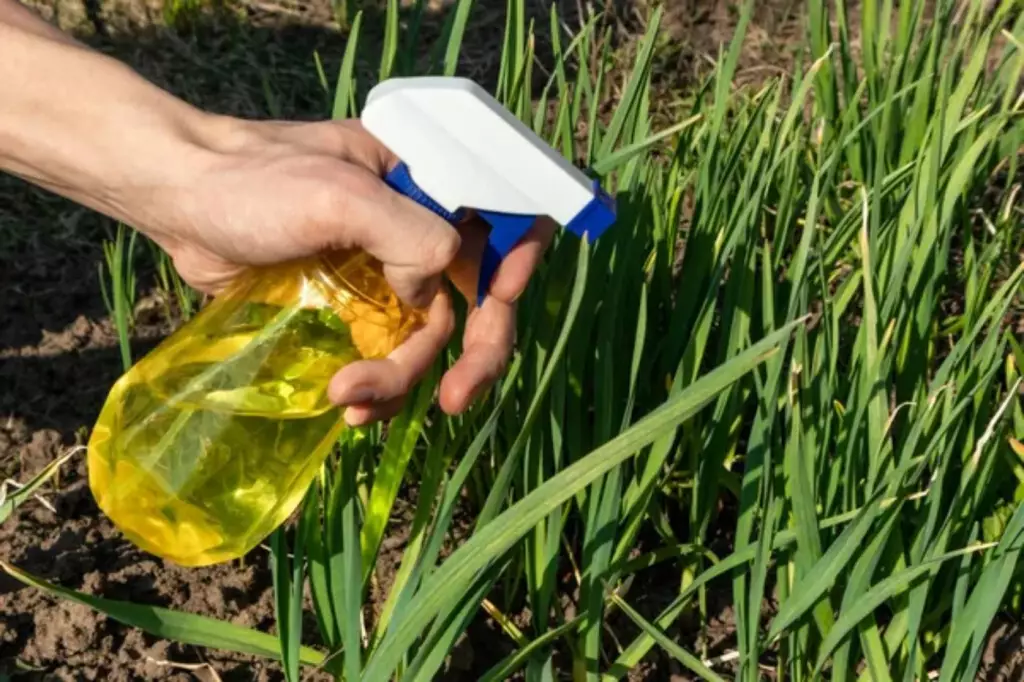
Aim to give 1 inch of water weekly, adjusting for rainfall. Test your soil's moisture level before watering; it should be moist, not soggy.
If you have sandy soil, it may need more frequent watering because it dries out faster. Follow these general guidelines:
- In sandy soils: Water may be needed more often to maintain moisture.
- In soils with better water retention: Watering frequency can be reduced.
Monitor local weather conditions as winter climates can vary. In regions with wet winters, you may need to water your garlic plants very little, if at all.
Remember, your garlic will still need some water during the winter, but be conservative. If you're unsure, check the soil, and water only when necessary to keep it from drying out completely.
How Much Water Do Garlic Plants Need in the Fall
When planting garlic in the fall, your watering approach should be measured and consistent.
Initially, water immediately after planting the cloves to help establish roots. This initial watering is crucial for starting your garlic on the right foot.
Throughout the fall season, maintain even soil moisture. You don't want your soil to be overly wet as garlic doesn't like to sit in water. Aim for a balanced moisture level; a soft dampness like a wrung-out sponge is ideal.
As you approach winter, taper off the watering. This reduces the risk of the bulbs rotting in colder temperatures.
It's always a good idea to check the moisture level of your soil using a simple finger test or a moisture meter.
If the soil feels dry an inch below the surface, it's time to water. If it still feels moist, hold off on watering for another day or two.
When to Stop Watering Garlic
As garlic matures and approaches the end of its growth cycle, the leaves will begin to turn yellow, signaling that the plant is entering the final stages of bulb development. This color change typically starts with the lower leaves and progresses upward.
This yellowing usually occurs in early June or a few weeks before the planned harvest, depending on your climate and the specific garlic variety. The exact timing can vary, so it's essential to observe your plants rather than relying solely on the calendar.
However, there are instances when the yellowing of garlic plants can be caused by an underlying issue, as discussed in this article.
Why stop watering garlic at some point?
Ceasing watering at this stage is critical for several reasons:
-
Skin development: Allowing the soil to dry out encourages the garlic to form stronger, dryer skins around the bulbs. These skins are essential for protecting the garlic during storage and extending its shelf life.
-
Flavor concentration: Reducing water stress on the plant helps concentrate flavors within the garlic bulbs, leading to a more potent and desirable culinary product.
-
Disease prevention: Over-watering garlic, especially late in its growth cycle, can increase the risk of fungal diseases, such as white rot and botrytis, which can ruin the crop and reduce storage life.
What you should do
-
Observe the plant: Regularly check your garlic plants as they grow. Pay particular attention to the color of the leaves. The change in leaf color is a natural indicator that the garlic is transitioning from growth to maturation.
-
Identify the cue: The first few lower leaves turning yellow is your cue to stop watering. This change signifies that the garlic has begun diverting energy from leaf production to bulb curing and skin formation.
-
Cease watering: Once you've observed the yellowing of the lower leaves, stop watering the plants. This will allow the soil to dry out gradually, which is necessary for the garlic to develop the strong, dry skins needed for proper storage.
After you've ceased watering, continue to monitor the garlic as it matures. The leaves will progressively yellow and wither, which is a normal part of the garlic's lifecycle.
When most of the garlic plant's leaves have turned brown, and only a few green leaves remain, it's generally time to harvest.
Best Irrigation for Garlic
The best type of irrigation for garlic generally needs to balance efficiency, water distribution uniformity, and the ability to minimize disease risk by avoiding water contact with the garlic foliage.
Here's an elaborate discussion of various irrigation methods and why certain types might be more suitable for garlic cultivation:
Drip irrigation
Pros of drip irrigation
- Efficiency: Drip irrigation is highly efficient in terms of water usage, delivering water directly to the root zone of the plants. This minimizes evaporation and runoff, making it ideal for regions with water scarcity.
- Reduced disease risk: By keeping foliage dry, drip irrigation significantly reduces the risk of fungal diseases, which is crucial for garlic since it's susceptible to various fungal issues.
- Weed control: Water is directly applied to the garlic plant, limiting the water available for weeds between rows.
- Flexibility and control: Allows for precise control over the amount and timing of water delivery, matching garlic's needs at different growth stages.
Cons of drip irrigation
-
Initial cost: The initial setup cost for drip irrigation can be high, although the investment often pays off in the long term through water savings and higher yields.
-
Maintenance: Drip systems require regular maintenance to prevent clogging of emitters and to repair leaks.
Sprinkler irrigation
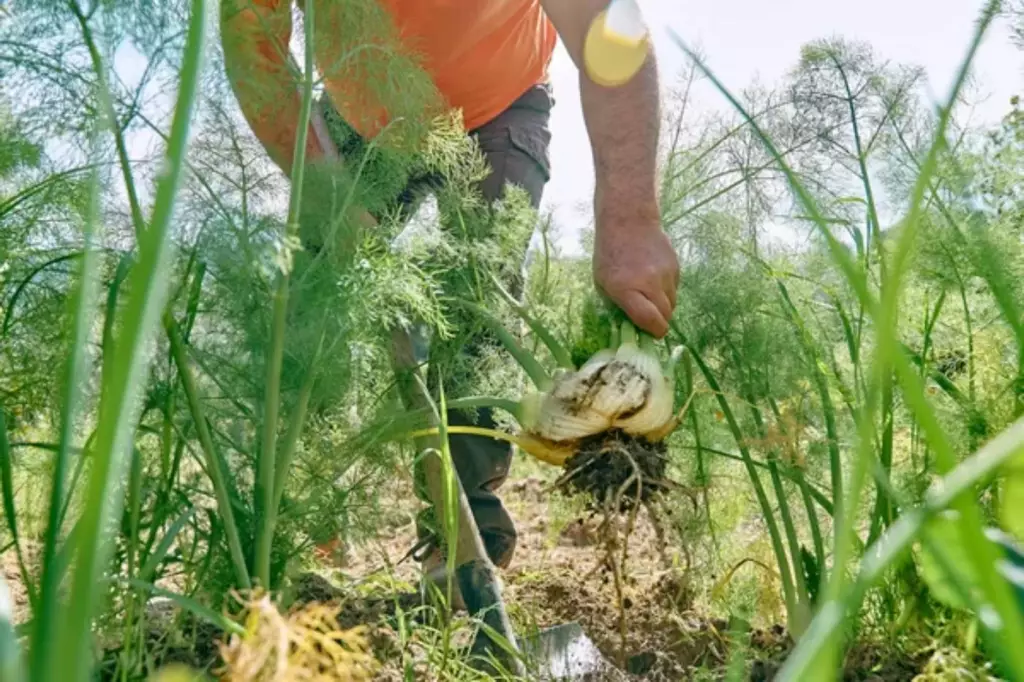
Advantages of sprinkler irrigation
- Uniform coverage: Sprinkler systems can provide uniform water coverage across a field, beneficial for large garlic fields.
- Versatility: Suitable for various terrains and easily adjustable to meet different watering needs.
Disadvantages of sprinkler irrigation
- Water loss: Higher potential for evaporation and wind drift compared to drip systems, leading to less efficient water use.
- Disease risk: Water contact with garlic foliage increases the risk of fungal diseases.
- Soil compaction: Heavy sprinkler applications can lead to soil compaction, affecting root growth.
Furrow irrigation
Benefits of furrow irrigation
- Low-cost: Furrow irrigation systems are generally less expensive to install and operate than drip or sprinkler systems.
- Simplicity: It's straightforward to set up and use, making it accessible for small-scale farmers or those with limited resources.
Drawbacks of furrow irrigation
- Water efficiency: Less efficient than drip irrigation, with higher potential for runoff and evaporation.
- Uneven distribution: It can be challenging to achieve uniform water distribution, especially on uneven terrain.
- Root disease: The increased moisture in the soil can lead to root diseases if not carefully managed.
